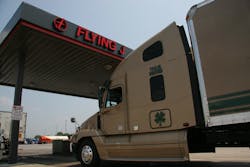The national average retail price for diesel fuel dropped ever so slightly in the U.S. this week, while retail prices for gasoline increased across all regions of the country, according to data tracked by the Energy Information Administration (EIA).
Diesel decreased 6/10ths of a penny to a national average of $2.115 per gallon this week, which is 66.9 cents cheaper per gallon compared to the same week in 2015, the agency noted.
Diesel prices decreased in only three U.S. regions this week, EIA said:
- The Lower Atlantic, down 4/10ths of a penny to $2.077 per gallon
- The Midwest, down 1.2 cents to $2.065
- The Gulf Coast, down 1.8 cents to $1.983 (the only region where diesel dipped under $2 per gallon)
Those declines offset the largest price spike of the week, which occurred in the Rocky Mountains: a 2.9 cent spike that pushed average prices up to $2.123 per gallon.
By contrast, gasoline prices increased in every region of the country this week, pushing the national retail average up 1.7 cents to $2.083 per gallon, though that is 33 cents cheaper per gallon versus the same week in 2015, EIA noted.
The agency added in its latest petroleum weekly missive that over the last three years, the share of premium gasoline in total motor gasoline sales has steadily increased to 11.3%, the highest share in over a decade.
While lower gasoline prices may be supporting demand for premium gasoline, the upward trend in sales is more likely being driven by changes in fuel requirements for light-duty vehicles (LDV) – a move EIA thinks will have widespread implications for future gasoline markets.“The latest corporate average fuel economy (CAFE) regulations, which were finalized in October 2012, set automaker LDV fleet-wide fuel economy for model years 2017-21 to a range of 40.3 to 41 MPG, with standards for model years 2022-25 rising to 48.7 to 49.7 MPG,” according to the agency’s update.
“To meet these standards, automakers are implementing a wide range of technical solutions to improve fuel economy," it said. "These solutions include, but are not limited to, weight reduction, conventional engine and transmission efficiency improvements, better aerodynamics, and further development and sale of hybrids and electric vehicles.”
One “significant trend” EIA identified where fuel economy is concerned is engine downsizing coupled with turbocharging, which aims to boost fuel economy with little or no performance compromise.
Yet because turbocharging forces more air into the combustion cylinder, it increases cylinder pressure and compression, and that increased compression boosts the risk of “engine knock,” the premature and incomplete combustion of fuel, which the agency said can damage the engine. Therefore, many turbocharged engines are requiring a higher octane rated gasoline to help offset the increased risk of engine knock.
According to EIA’s data, in model year (MY) 2009, turbocharged vehicles accounted for 3.3% of new gasoline-fueled LDV sales, but by MY 2014, their share was more than five times greater at 17.6% and this trend is expected to continue, with turbocharged engines projected to account for 83.3% of the LDV market by 2025.
That trend may also lead OEMs to recommend or require more LDVs to use higher-octane gasoline, the agency said, pointing out that as of MY 2013, higher-octane gasoline-fueled LDVs accounted for 14.2% of the total gasoline-fueled LDV market.
“Engine models that require premium gasoline are designed to operate only on that fuel, and the use of regular gasoline risks damaging the engine,” it noted.
About the Author
Sean Kilcarr
Editor in Chief
Sean Kilcarr is a former longtime FleetOwner senior editor who wrote for the publication from 2000 to 2018. He served as editor-in-chief from 2017 to 2018.

